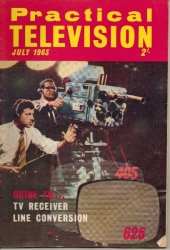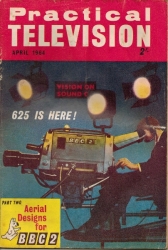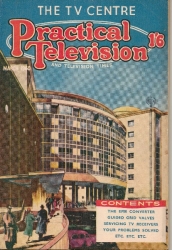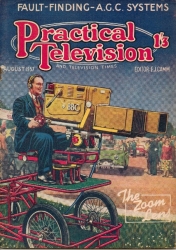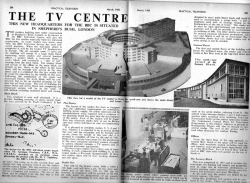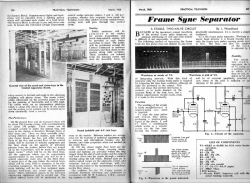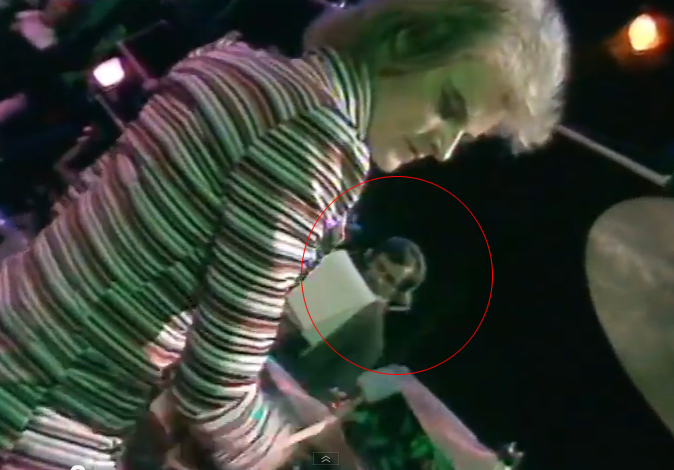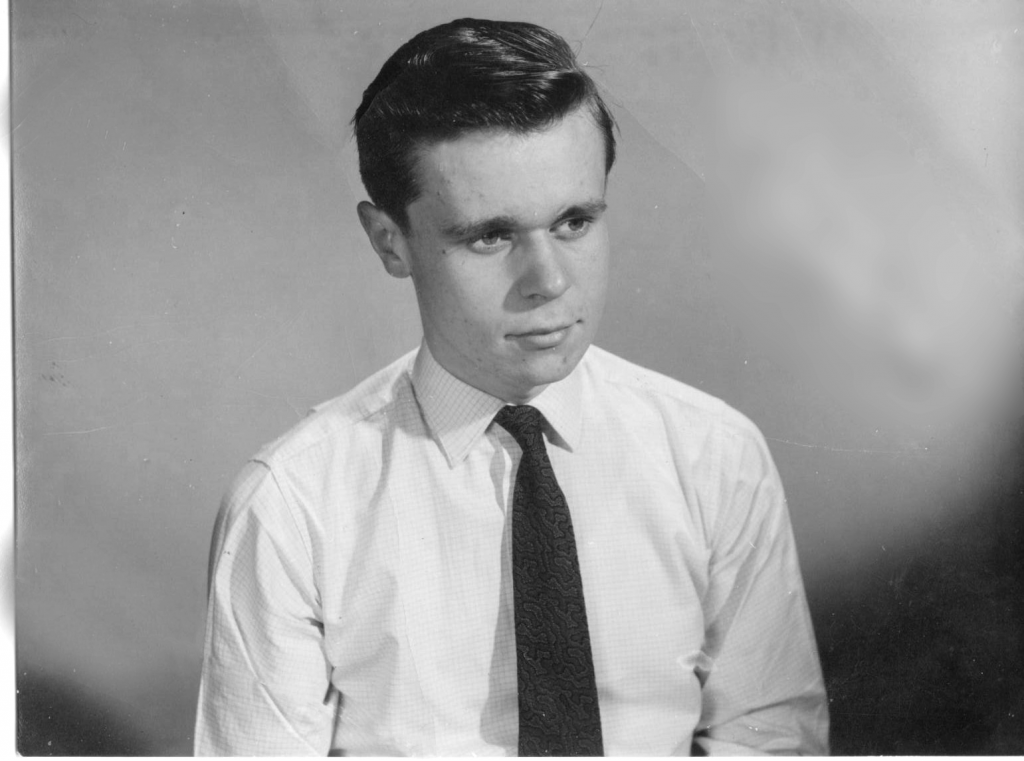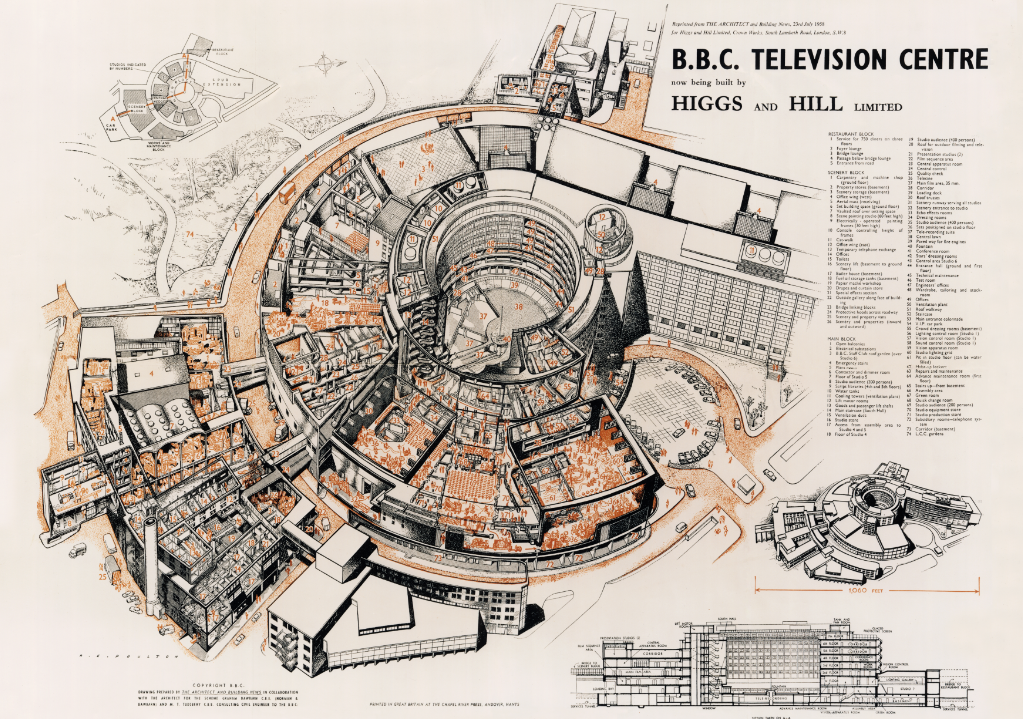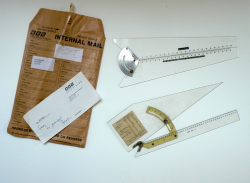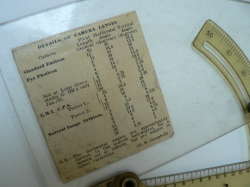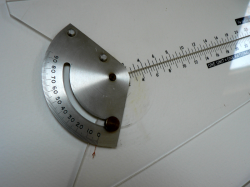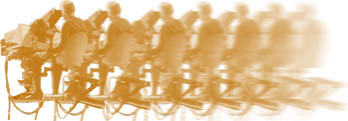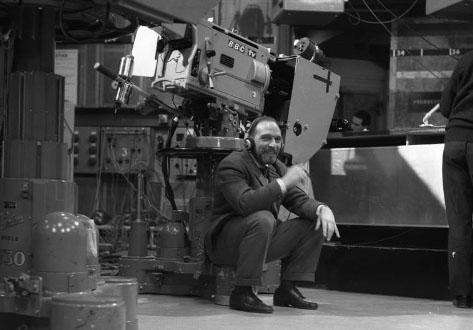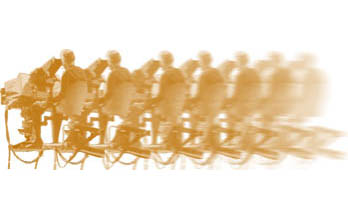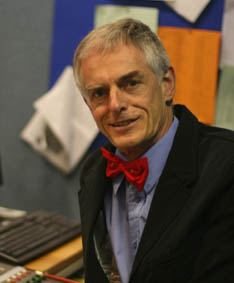
Dave with his Children in Need bow tie
Dave Howell was one of the first people to work on EastEnders, as one of the two Gram Ops
This is a reprint of an article that appeared in “The Walford Gazette” in November 2004, (twenty years after the start of EastEnders) about the early days of the twice weekly ‘Soap’
From 1970 I was working as a ‘Soundie’ in Tech Ops at Television Centre on the general mix of programmes, from “Grandstand” to “Playschool”, “Dad’s Army” to “The Good Life” etc, etc.
In November 1984 was asked to be one of the two Gram Ops, (one for each Crew) to work on a new twice weekly Flagship serial drama.
 Producer Julia Smith wanted it to be lively, raucous and have the reality of an east end market environment. So in mid November 1984, before we even shot one scene, John Relph (my Oppo on the other team) and I went off to Ridley Road Market with a Nagra Tape recorder to capture some new market and train sound effects etc. We were immediately struck by how much music you hear from various stalls in Markets! All non-clearable of course, but we did manage to get some clean and lively effects.
Producer Julia Smith wanted it to be lively, raucous and have the reality of an east end market environment. So in mid November 1984, before we even shot one scene, John Relph (my Oppo on the other team) and I went off to Ridley Road Market with a Nagra Tape recorder to capture some new market and train sound effects etc. We were immediately struck by how much music you hear from various stalls in Markets! All non-clearable of course, but we did manage to get some clean and lively effects.
It started to rain so we decamped to a covered stairway to continue recording and would you believe it, a copper came up to us and said “Ello ‘ello, and what are you two up to then?” And we even had it on tape !!!
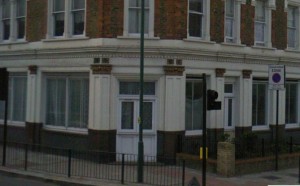
The pub at the top end of Wood Lane in 2011
Whilst we were in the area we decided to go and see the east end square on which Keith Harris had based Albert Square (the original series designer, not the one with his hand up a green duck….) We were amazed to walk into Fasset Square and realised that 3 sides of Albert Square were an almost exact replica of what was before us. We walked into the garden, but when we turned round nearly jumped because there was a blooming great white building behind us that shouldn’t be there! It was a several storey white carbuncle of a building which was in fact a german hospital. But it didn’t belong there, not when you were used to Albert Square. I believe The Queen Vic was based on the College Park Pub at the top of Scrubs Lane W12.
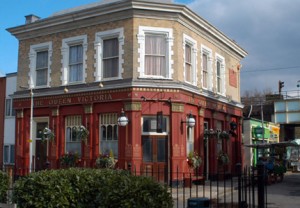
The Queen Vic
John and I put a lot of effort into compiling various sound effects and music reels all spliced with colour coded leader (to supplement the BBC sound effects library on 7” 33rpm vinyl discs.) But as we were to sound dub in a Sypher suite at Television Centre we had to duplicate everything for there too. During a week of ‘Prep and rig’ in Elstree Studio C we were given the title music master ¼” tape and so started making copies of the various versions. I don’t think the ‘Honky Tonk’ version was ever heard again! I always seem to whistle the last piece of music I’ve heard, and twenty years ago I still had enough energy to go to the gym after a short 8 hour day’s prep. So all through the evening I was whistling the EE Sig tune thinking, no one knows this yet, but they soon will !
One of our FX wildtrack recording sessions involved going into a pub and getting some real east end pub chat. Unfortunately I saw the funny side of a group of sound guys all sitting with pints and a recorder in a bag but not talking, and I got the giggles, so a large chunk of the recording was useless!
Originally the EastEnders lot just consisted of Bridge St and three sides of the square (The B&B side was a later addition) The interior sets were all in Studio C using its own control room with an antiquated Neve sound desk left by the previous owners ATV.
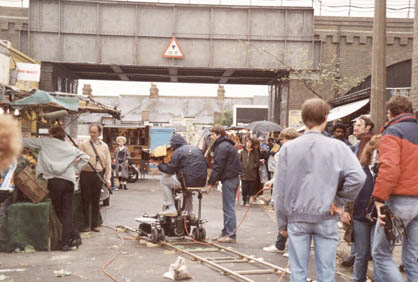
Bridge Street
We used to have a ‘Tech. Run’ of the studio stuff in the Sets in Studio C, when the whole cast would ‘perform’ and technical crew would watch, listen and make notes of the complete action in story order. Bearing in mind that the cast were working on just two episodes at a time they were generally word perfect, but they did have the script well ahead and it rarely changed. I do remember how cold, gloomy and depressing it seemed in the studio with just the house lights on! My endearing memory of tech runs is of Anita Dobson and Gillian Taylforth giggling incessantly and Bill Treacher dashing onto the set with a cheery “Hello, y’alright son”
In the original rehearsal script the working title was “East 8” and dear Ethel’s dog was called Phillip, but by the time we got the camera script it had changed. Obviously less comedy potential from a royal than Ethel’s Willy !!!
The lot inserts were recorded (several times for perfection) in a small van that was called ‘Insert Unit 1’ and would drive into the lot and park up hopefully somewhere out of shot. It had 2 cameras and contained one reel-to-reel VT machine & VT Op, a Sound Supervisor, sound desk and Nagra ¼” tape machine, a ‘racks’ engineer to deal with colour balance, a vision mixer to cut between the 2 cameras and a production assistant to call shots and log takes. Generally the lighting director would be peering in through the door with black drapes round his head to see his contribution to God’s lighting. It was incredibly cramped and got unbearably hot!!!
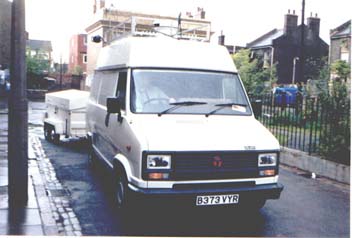
The Inserts Unit
With long cable runs to the mics mounted on poles skilfully operated by the sound crew to ‘collect’ the sound, induction (breakthrough) of Radio 2 on 1500 metres Longwave often necessitated re-routing cables to minimise the interference from DJ’s David Hamilton, John Dunn, or The Jimmy Young show!
The radio Talkback system was pretty unreliable and apparently when it failed it was quite usual for 1 toot on the van’s horn to indicate that VT was up to speed and 2 toots for VT stopped!
[youtube]http://www.youtube.com/watch?v=-lfODZmHlMc&feature=youtu.be[/youtube]
A trail shown before the series started
So it was a week in Mid December 1984 it really started, just 2 studio days with recording in the evenings only, down the line to Television Centre! We rehearsed all day, complete scenes, in story order, with cameras and booms rushing up and down between the only sets we had: Vic, Fowlers, Café and Launderette, Doctor Legg’s Surgery and a grotty flat. The studio cameras were the excellent, but enormous, EMI 2001’s which required one and a half hours line-up before recordings!
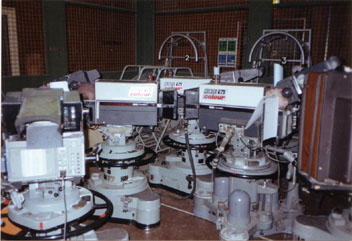
Last day of the 2001s
Lunch break was invariably an hour at 1 o’clock, we had a 15 minute tea break with a real tea lady with trolley and cakes at about 4 with all the cast & crew congregating in the long corridor, and Supper break was one hour from 6 plus a half hour Line-up. So we would record 7.30 – 10 pm at Television Centre.
We were crews that had been trained on ‘as live’ drama such as “Softly Softly”, “Onedin Line”, “Play for Today” & “Crackerjack” etc ! The tradition in those days was to provide as complete a programme as possible, and so I played in all the sound effects on-the-fly from three enormous ¼” tape machines, leaving only the Vic & Café music off until the dub, just in case of the occasional edit. Every time anyone opened any ’outside’ door it would be a gentle pull on the exterior fx fader and a lift of the high frequencies. Just think how many times that café door is opened in the average episode! Every phone or doorbell that rang, run up or downstairs, oov line, car horn & taxi arriving outside was played in. The east end brought to life with sound effects.
The very first scene included Den, Arthur & Ali coming up stairs, out-of-vision, entering a room to find the first character to be seen on Eastenders who was………Reg………. almost dead! The shortest part ever. The most memorable line in the first Fowlers Kitchen scene with all the family trying to get breakfast, was from the original Mark Fowler “Mum, where d’ya keep the bog rolls?” A classic!
There were rarely errors. We might pick up the odd shot for soft focus, boom shadow, or a line that went slightly awry, but Julia ruled with a rod of iron and woe betide you if you weren’t 100%.
I remember at the end of the 1st episode (Directed by Mathew Robinson) Nick Cotton had an out-of-vision shout on exiting the Vic. It sounded awful in rehearsals doing it just off the set, so I took him outside and recorded it outside for a very real ‘exterior acoustic’
We arranged with John Altman that we would play that line in off tape, but of course, pressure of the first night, he forgot and so we got both. Mathew growled and virtually climbed over the production assistant to berate us for causing a retake, even though it was in the pursuance of art!
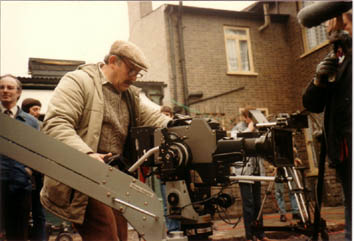
Geoff Feld on an early episode
At the end of the second recording day I played the ¼” closing music and the Aston character generator operator was to cut between captions on the beat of the music. Unfortunately the chap was cutting anywhere but on the beat and so by take 3 Julia said “Cut, we’ll do it at the Edit” and the guy had to endure just a little wrath from Julia. We never played the closing music in the studio ever again. Then we were amused to have a drink in the Vic with practical beer pumps on the set, cast, crew engineers & production team all congratulating our combined efforts.
After the edit the Studio Sound Supervisor and Gram Op would dub their own pair of episodes at the end of the next week in Sypher 1 at TVC. Two sessions prep by the Gram Op & the following day to dub, when the roduction assistant and director would arrive. Quite a sociable affair.
This is when we would smooth any bumps that the VT edit had given and add music to Vic & café scenes from a selection of pre-cleared tracks that were predicted would be in the charts 6 weeks later for the Transmission date.
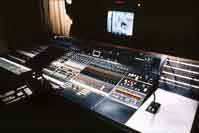
Sypher (borrowed till I get my own from VT Oldboys)
During the dub Mathew had been furiously scribbling notes and I thought we had a lot of changes coming, but after the review he said “Can we record a vocal track to the music in here?” So he persuaded his lovely welsh assistant to sing his lyrics to the EE Sig tune and we recorded it on ¼”. And pretty good she was too!
So the routine had started. We continued honing our operation to a peak by transferring all the background effects to cart machines that would play them in an endless loop.
Every door open/close, lock, bolt and back gate was recorded, edited, catalogued and card indexed, and all duplicated for TVC! As we rarely met the other team we started a ‘Dear Dave/John‘ Diary to pass information on.
Just before the first episode transmitted on Feb 19th 1985 we were all called up to Bridge St for a team photo of the production & technical team, similar to the ones that you see on display of the cast. A snapper from The Telegraph was up on the bridge looking down Bridge St towards the gardens so we arranged ourselves accordingly and stood around for ages while the guy took about 30 photos.
I duly bought a copy of The Sunday Telegraph interested to read the article about the BBC’s newest programme and to see the double page photo. It was in the early days of colour prints in newspapers and it was awful. It was all out of colour registration so everyone had a fuzzy aura! At least the article was in focus!
After my first 6 months on EE passed I was back to TVC for a variety of other live & recorded programmes to allow another gram op onto the rota so we had some cover for leave etc.
Many changes occurred such as afternoon recordings and recording-out-of-order as the production process evolved. The Launderette 2nd shift arrived with June, and Pam followed.
Even VT machines on site after a whole recording session was lost when a digger went through a cable between Elstree and TVC !!!
In between working on other programmes, I have been back working at Elstree on and off ever since, in recent years as Sound Supervisor.
EastEnders really does seem like an old friend. (One you want to shout at occasionally !!!)
Dave Howell
Sound Supervisor
2004

